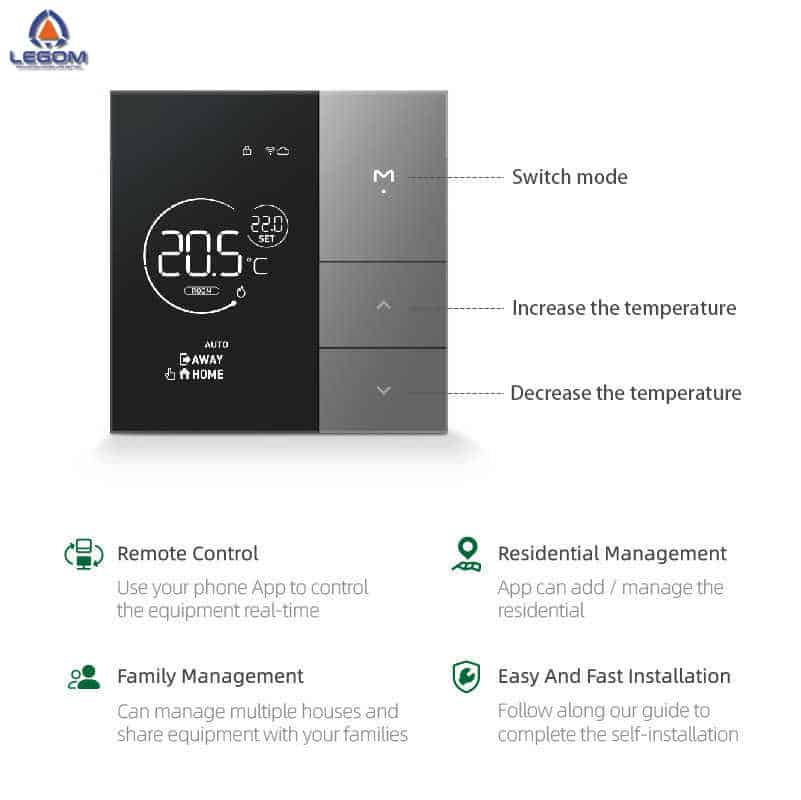
The HVAC thermostat, a key component of the heating system, plays a crucial role in controlling and maintaining the desired room temperature. It offers high precision in temperature settings, allowing users to tailor the environment to their comfort. Additionally, modern thermostats can connect to Wi-Fi, enabling remote control via smart devices.
Judging from its advantages, this thermostat brings a high level of precision in setting room temperature. With the ability to specify a desired target temperature, users can create an environment that suits their comfort preferences.
What’s more, some modern models have the ability to connect to a Wi-Fi network. It allows users to control the heater remotely via mobile devices or other smart devices.
Overall, an HVAC thermostat is vital for efficient, safe, and comfortable temperature management in your home.
Contents
The Importance of Using a HVAC thermostat
The use of a HVAC thermostat is very important because it provides a number of significant benefits in the operation of room heating. The following are several reasons why using a thermostat on an HVAC system is considered important.
Energy Efficiency
The thermostat allows precise temperature regulation. By setting target temperatures and using automatic controls, heaters can work more efficiently. This helps reduce energy consumption and heating costs.
User Convenience
HVAC thermostats provide convenience to users by allowing them to set the desired temperature. Users do not need to manually monitor or adjust the heater continuously.
Automatic Setting
The HVAC thermostat enables automatic setting of the heater. Once the temperature reaches the desired level, the heater will automatically turn off or reduce power. This helps keep the room temperature stable.
Safety
Some thermostats are equipped with safety features, such as automatically turning off the heater if the temperature gets too high. This provides protection against the risk of overheating and can prevent potential fires.
Schedule Programming
Some modern thermostats have programming features that allow users to set operational schedules. This allows the heater to work as needed at certain times, increasing efficiency and saving energy.
Reduces Overheating
With a thermostat, the temperature can be maintained at a comfortable level without overheating. This helps create a healthy and comfortable environment.
Precise Temperature Control
The thermostat provides precise control over room temperature. This allows users to adjust the temperature according to individual preferences.
Thus, the use of the thermostat on an HVAC system not only provides better control over heating. But it also contributes to energy efficiency, safety and comfort of room occupants. Therefore, the thermostat is considered an important component in modern heating systems.
Choosing the Right Thermostat: Energy Efficiency and Comfort
The choice between the two will depend on individual needs and preferences, as well as the context in which the room heating is used. That said, here are some considerations to help decide which is better.
Energy Efficiency
The thermostat on an HVAC system can help improve energy efficiency by automatically adjusting the temperature based on user preferences. If energy efficiency is a priority, using a thermostat can be a good choice.
User Convenience
The HVAC thermostat provides extra comfort with precise temperature settings. If user comfort is a major factor, this thermostat may be a better fit. Especially for those who don’t want to constantly set the temperature manually.
Additional Features
Some room heating may come with additional features, such as air cleaning, greater safety, or a more aesthetic design. If these features are important, then a heater with them could be a good choice.
Electricity Availability
Some room heating may require higher electrical power than others. If electrical resources are limited, selecting a heater with lower power consumption may be more appropriate.
Specific Heating Needs
Sometimes, certain types of heaters are better suited for specific heating needs, such as convection heaters for large rooms or ceramic heaters for fast heating. Consider the type of heater that best suits your room’s needs.
Budget
The thermostat on room heating may add slightly more costs compared to a heater without a thermostat. If budget is a primary consideration, it’s worth considering how important the thermostat’s features are.
Flexibility of Use
Some room heating may be more portable or can be moved easily. If you need flexibility in heater placement, a more portable option may be more appropriate.
In other words, this thermostat is suitable for use by users who want more precise control over room temperature and want to increase the efficiency of energy use. Also, users who want to take advantage of more advanced temperature control and automation. Therefore, you should consider the features that are most important to you and adjust them to the conditions of use in your room.
How to Set a Thermostat on an HVAC system
Setting the HVAC thermostat generally involves a few simple steps. The following is a general guide to setting the thermostat on a room heating.
First, make sure you understand the basic functions of a thermostat. This may include the ability to set target temperatures, time programming, and use of other special features.
Then, turn on the room heater using the power button. On the HVAC thermostat, look for the control to set the target temperature. Next, turn the dial or press the up/down button until it reaches the desired temperature for the room. Some thermostats also have digital displays that make it easier for you to see the set temperature.
If your room heating has a time programming feature, you can set the heating schedule according to your daily or weekly preferences. After setting the target temperature, ensure the heater starts operating. You may hear the fan or see other indicators that the heater is active.
Some room heating are equipped with automatic shut-off when the temperature reaches or exceeds the target. Make sure to understand this feature and check whether the heater turns off automatically when it reaches the set temperature. To be more efficient, make sure to turn off the room heater when it is not needed.
